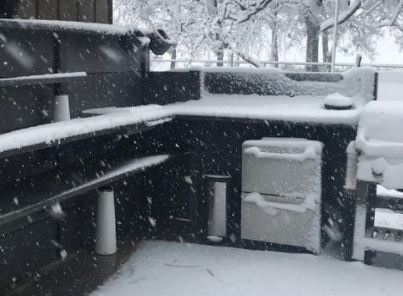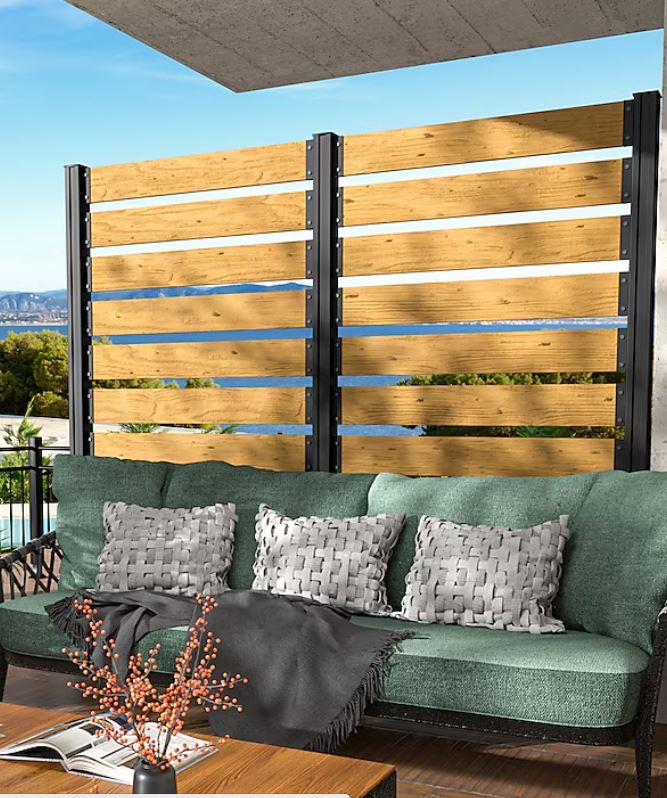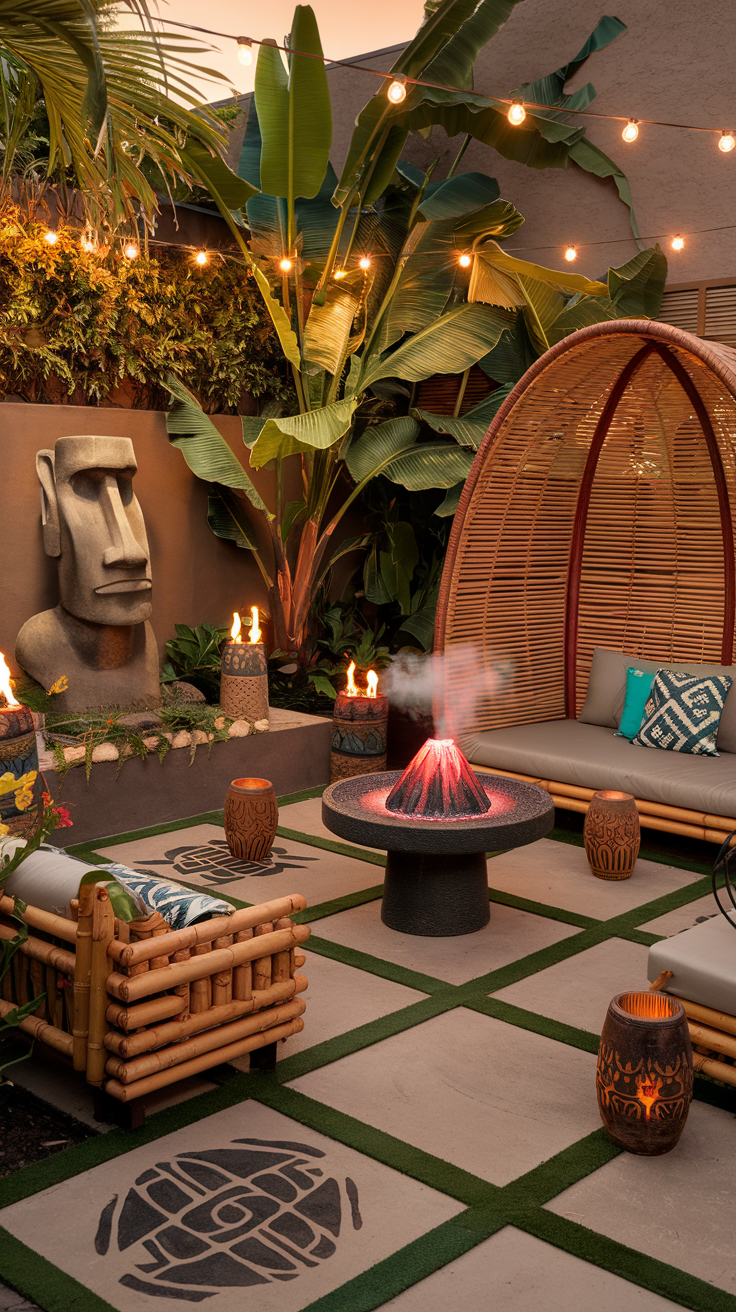9 Clever & Decorative Patio Downspout Drainage Ideas
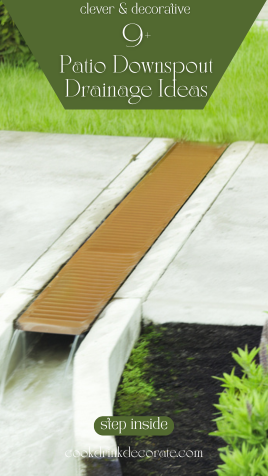
9 Clever & Decorative Patio Downspout Drainage Ideas
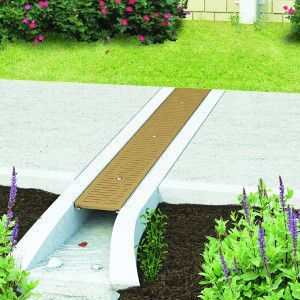
Downspouts and downspout drainage are an important part of your patio’s drainage system, but they don’t have to look boring or out of place. With the right ideas, you can turn them into features that add beauty to your outdoor space while helping manage rainwater.
Choosing clever and decorative downspout drainage ideas helps protect your home’s foundation and keeps your patio looking attractive. You’ll discover simple ways to blend drainage solutions with your style, making your backyard both practical and visually pleasing.
Rain Chain to Rock Basin

One creative way to upgrade your patio drainage is to use a rain chain that flows into a decorative rock basin. Instead of letting water rush through a plain metal pipe, a rain chain lets each drop travel visibly down a series of linked cups or chain links. This not only handles runoff but also adds a gentle, calming sound during rainfall.
A copper rain chain is a classic choice. It weathers beautifully over time and becomes a standout feature by your patio. As water runs from the gutter to the bottom, the chain guides it right into a rock basin or bowl.
Place the basin at the end of the chain, then surround it with smooth river rocks. These help slow down water flow and cut down on splashing. You can tuck in drought-tolerant plants nearby to take up extra moisture and soften the look.
This idea combines function and style. It turns basic patio drainage into a mini water feature and landscape accent. Rain chain ideas like this are easy to personalize with different types of stones, metals, or even colored glass basins.
You don’t need a lot of space for this downspout drainage project, and you can match the materials to your patio design. Whether your space is modern or more natural, a rain chain connecting to a rock basin fits right in and makes rainy days a bit more enjoyable.
Stone Trough with Integrated Drainage Channel
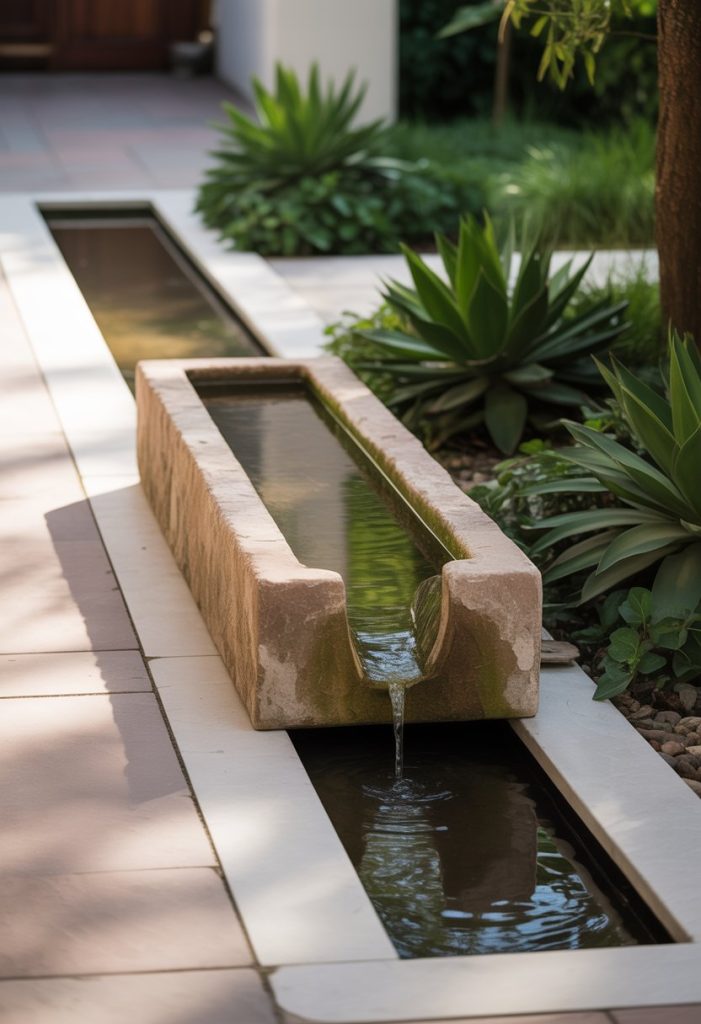
A stone trough drainage channel can give your patio a fresh and natural look. You create a shallow trench and line it with stones or granite slabs, turning a simple drainage solution into a design element.
This channel carries rainwater away from your patio area, helping keep it dry while adding interest to your landscape. As water moves through the stone channel, it looks like a small, modern streambed.
You can lay smooth river rocks, flat stones, or even mosaic tiles for different styles. Match the color of the rocks to your patio for a seamless look or choose contrasting tones to make the channel stand out.
You might want to plant some low-maintenance grasses or groundcover along the sides for extra greenery. These plants help soften the edges and blend the channel into your yard.
A stone trough works well with any garden style, from rustic to modern. It’s a reliable way to manage water and still enjoy a stylish patio. Plus, you can build it yourself with simple tools and materials found at most garden centers.
This type of drainage doesn’t need much maintenance. Just check for weeds or leaves now and then, and clear out any blockages so the water keeps flowing smoothly.
Decorative Splash Block + Gravel Swale Combo

You can make your patio drainage both practical and attractive with a decorative splash block and gravel swale combo. Start by choosing a cast concrete or stone splash block. Pick a fun style, like a leaf shape, mosaic pattern, or crisp geometric design, to match your outdoor space.
Place the splash block at the end of your downspout. This helps guide rainwater away from your patio and stops soil erosion right where the water falls. Decorative splash blocks look much nicer than plain concrete and give your drainage a personal touch.
Next, build a narrow trench that runs from the splash block along your patio edge. Fill it with small river rocks or gravel. This forms a swale that lets water drain away gently without causing puddles or mud.
The gravel blends into most landscaping styles. You can even add small flowers or garden stones along the edge for extra color. This drainage setup fits in with modern, traditional, and cottage-style patios all alike.
With this combo, you get reliable drainage and a fresh look for your backyard. You won’t need to hide your downspout—it becomes a little feature you can show off. Plus, it’s easy to clean out leaves or debris by hand if needed.
Planter Box Drainage Redirect
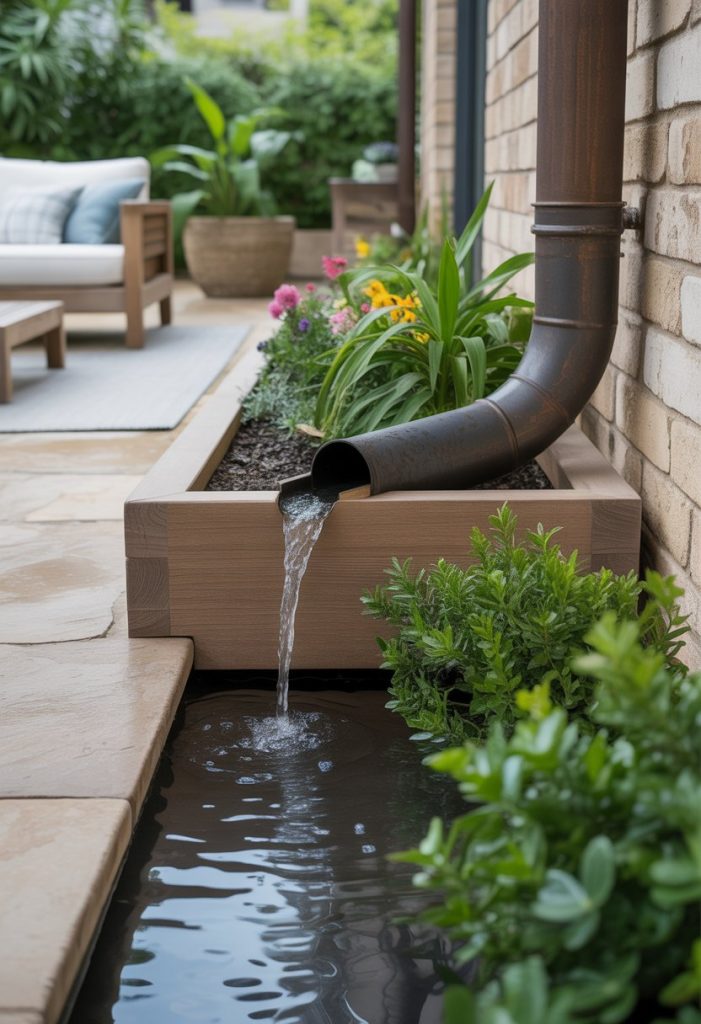
If you want to control water from your downspout and add some style, try using a planter box for drainage. Place a long, raised planter box directly underneath your downspout. This way, you can use plants to soak up some of the rainwater.
Build your planter box with a perforated drain pipe at the bottom. As water flows in, the plants drink what they need. The extra water then moves through the pipe to a safe spot away from your patio.
Choose sturdy plants that like lots of water, such as ferns, sedges, or marsh marigolds. You can even grow herbs and vegetables if your patio gets enough sun. Lining the bottom of the box with gravel helps with drainage and keeps soil from clogging the pipe.
This setup keeps your patio dry and reduces puddles. It looks nice too, especially when the planter is full of colorful flowers or lush greens. Because the drainage pipe is hidden, everything looks neat and tidy.
With a planter box drainage redirect, you turn a problem area into an eye-catching garden feature. Your space stays safer and more attractive, and the plants benefit from the extra water. It’s a simple option that works well for most patios.
Dry Creek Bed with Stepping Stones
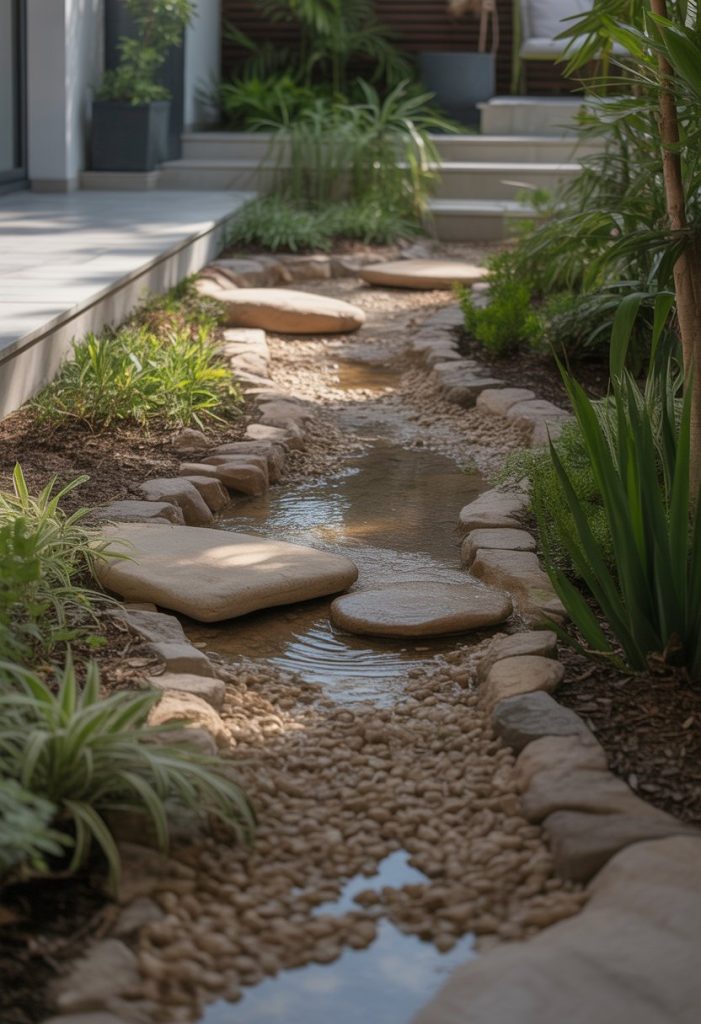
If you want to make drainage look attractive, guide water away from your patio using a dry creek bed. Start by digging a shallow, winding trench where water naturally flows or tends to pool. Line this trench with landscape fabric to help block weeds.
Fill the creek bed with a mix of smooth river rocks, pebbles, and larger boulders. Cluster small ornamental grasses or low plants along the edges for a more natural, lush look.
To add function and charm, place flat stepping stones across the creek bed. These stones make it easy to walk through your yard even after heavy rain. The stepping stones can match your pathway or stand out as decorative accents.
A dry creek bed lets rainwater move away from your patio while adding visual interest to your garden. During dry days, it doubles as a pretty feature that fits into most landscapes.
Decorate with little touches like faux frogs, small garden statues, or colorful pebbles to give it personality. You’ll get a yard feature that works hard and looks good all year round.
Decorative Ceramic Pipe Runoff Feature
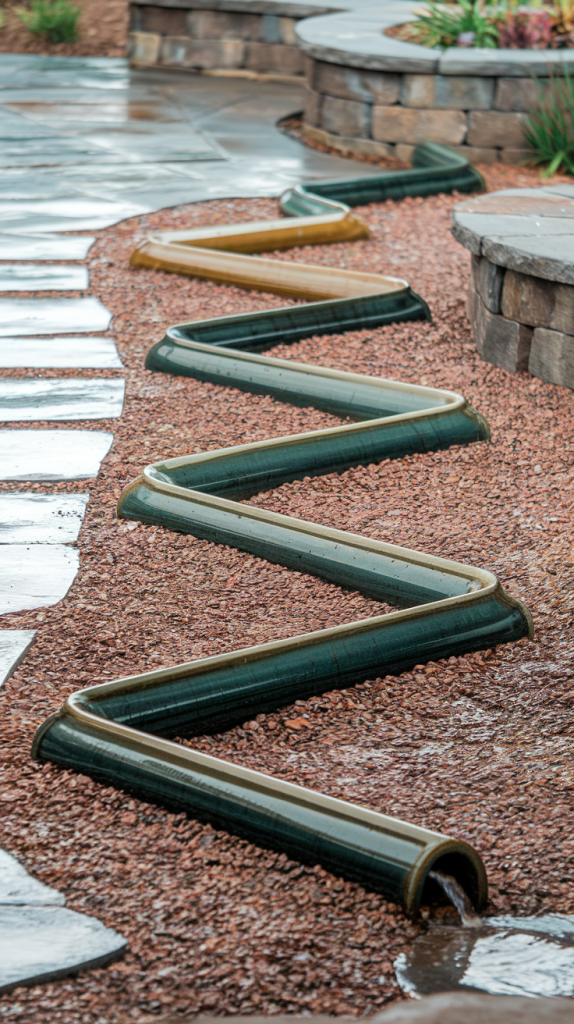
If you want your patio drainage to stand out, consider a decorative ceramic pipe runoff feature. This idea uses shiny ceramic half-pipes or even big broken tile pieces to guide water away from your home. The pipes can be placed in a zig-zag pattern, making the path both practical and eye-catching.
You can choose colors and patterns that match your outdoor space. Glazed ceramics offer a smooth surface for water, so everything flows easily even after heavy rain. The unique shapes and glossy finishes will catch the sunlight and add a fun splash of color to your yard.
This setup acts like a mini art display, but it still does an important job. Water moves smoothly through each half-pipe, traveling safely away from the patio. The zig-zag pattern helps slow the flow a bit, which can stop soil from washing away.
Your guests will notice this creative drainage feature right away. It adds style without any complicated parts or moving pieces. All you need is a few well-placed ceramic pipes or tile sections and a little imagination to transform run-off into a cheerful garden detail.
Modern Drain Grate Strip Set in Pavers
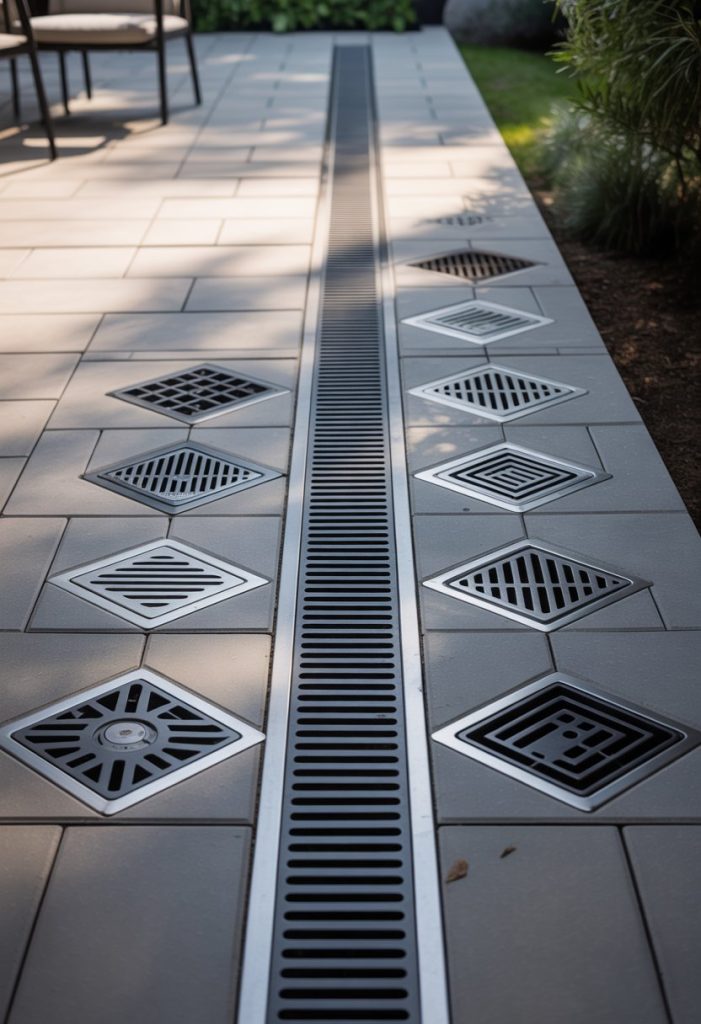
A modern drain grate strip is a sleek way to handle water downspout drainage on your patio. You can install a slim, linear drain channel right where your patio meets your house. This helps catch rainwater or runoff before it reaches your home’s foundation.
Choose a stylish steel or bronze grate to add some design elements. These grates fit flush with the surface and blend naturally with your patio pavers. They won’t stand out or create a tripping hazard.
Because the grate is narrow and linear, it won’t take up much space or look bulky. It’s a discreet drainage solution that works well with both large paved patios and smaller outdoor spaces.
You can run the drain strip along the entire length of the patio where water tends to collect. This approach keeps your patio dry and helps prevent puddles or slippery spots.
Cleaning and maintenance are simple, too. Just lift the grate to remove leaves or debris from the channel below. With this kind of drainage, you get modern style and peace of mind without any extra fuss.
Terraced Gravel Pads with Inset Lights
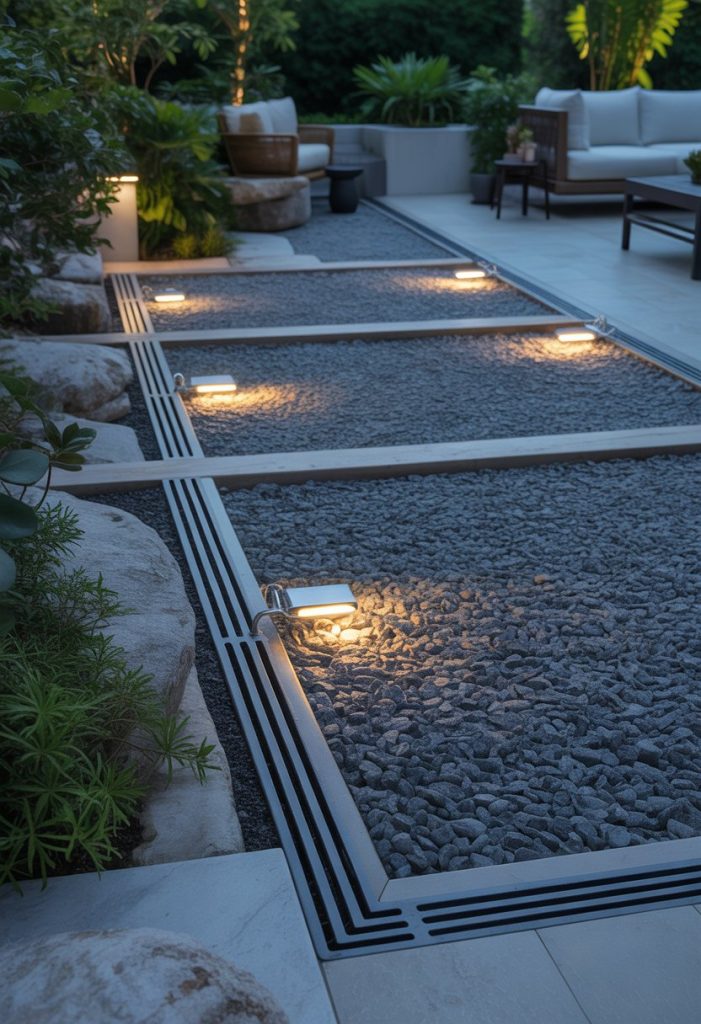
You can transform your patio’s downspout area by building terraced gravel pads. These small, step-like terraces guide the water downhill, slowing its flow with each level. Picture each pad edged with corten steel or stone pavers to keep the gravel tidy and contained.
Gravel is a practical choice because it absorbs and filters rain, helping to prevent water from pooling near your home. The layered design also adds depth and interest to your landscape. You can choose river rock or crushed stone to match the style of your patio.
For extra charm, set low-voltage lights directly into the gravel or along the steel borders. These lights make the feature stand out in the evening and improve safety by showing each step clearly. At night, the pathway glows softly, giving your yard a cozy and welcoming feeling.
This drainage idea is both useful and decorative. It works well in many settings, from small yards to wide patios. You get to enjoy a dry patio while adding a modern look to your outdoor space.
Green Drainage Run with Moss or Groundcover
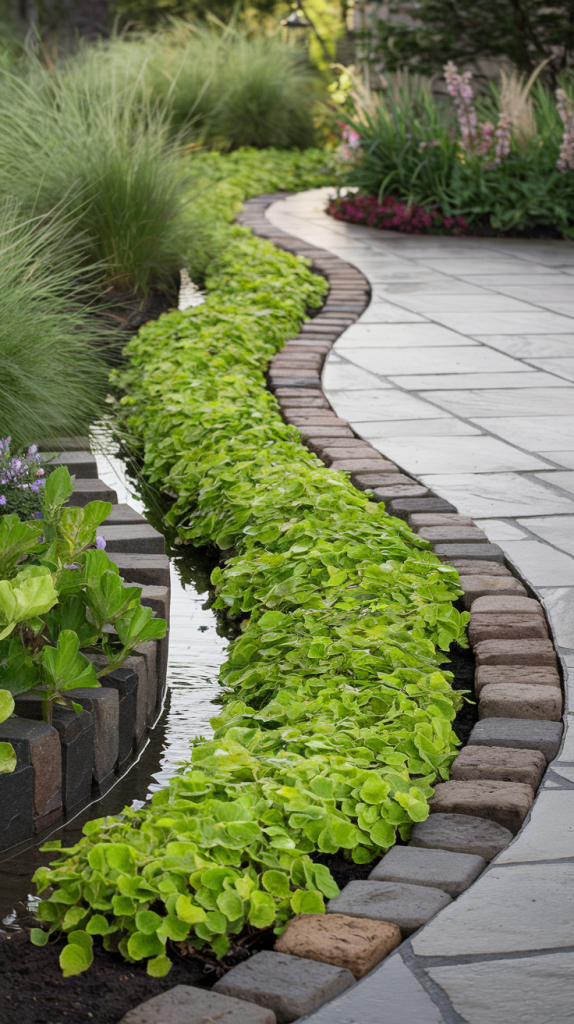
Who says downspout drainage can’t be beautiful? This green drainage run is a landscape-forward solution that turns a runoff path into a soft, lush garden feature. Instead of a concrete trench or exposed pipe, a gentle channel is formed and lined with vibrant groundcovers like creeping Jenny, Irish moss, or even dwarf mondo grass. These moisture-loving plants help absorb excess water, slow runoff, and visually soften the hardscape edge of your patio.
Framed with natural stones or cobblestones, the path subtly curves away from the home, guiding water out while blending seamlessly into the rest of your landscape. It’s perfect for patios that border gardens or lawn spaces — especially in shaded or low-traffic areas where moss thrives. During drier seasons, it still reads as a serene green ribbon among your planting beds. Add a few ornamental grasses or flowering border plants for color, and this becomes one of the most photogenic drainage solutions in your yard.
Key Considerations For Patio Downspout Drainage
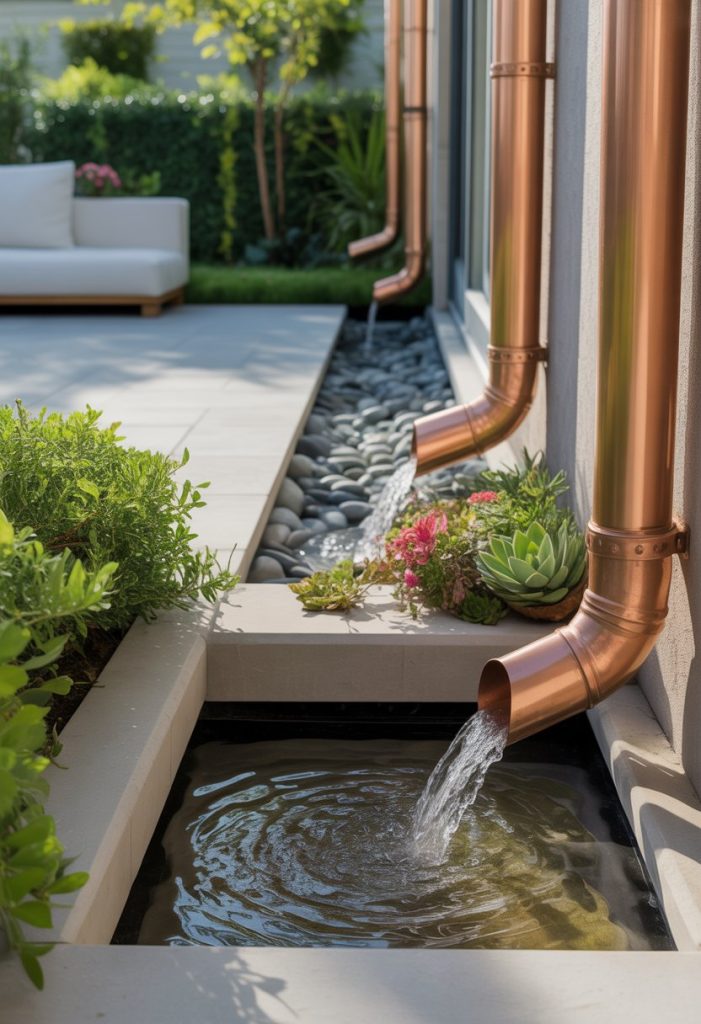
Choosing the right downspout drainage for your patio helps protect your foundation, landscaping, and patio surface from water damage. Planning ahead and understanding the basics will keep your drainage working well and looking neat.
Understanding Water Flow Patterns and Downspout Drainage
Start by identifying where water collects around your patio during heavy rain. Watch how water moves off the roof and along the patio surface. Take note of low spots, downspout placement, and any areas where water pools. This helps you decide where to direct water away safely.
It’s smart to look at the slope of your patio. Water should always flow away from the foundation. Use a level or even a ball to check which direction the patio tilts. For best results, patios should have a slope of at least 1/4 inch per foot.
Check if your soil drains quickly or slowly. Clay soil holds water longer, while sandy soil drains faster. This affects which systems, like French drains or gravel trenches, will work best in your yard.
Common Drainage Pitfalls To Avoid
Avoid sending water toward your house or a neighbor’s property. This can lead to flooding or foundation damage. Always divert water to a safe spot, such as a street drain, rain garden, or dry well.
Don’t let your downspout end too close to the patio edge. Water that isn’t carried far enough away can erode soil or cause slippery spots. Extensions, splash blocks, and underground pipes move water where you need it.
Skip burying pipes without enough slope or proper outlets. Clogged and level pipes can cause water to back up. Make sure all drains remain clear of debris, especially after storms. Clean out leaves and dirt regularly to keep everything working smoothly.
Tips For Maintaining Decorative Downspout Drainage Solutions
Taking care of decorative downspout drainage not only helps your patio look nice but also protects your home from water damage. Regular maintenance keeps everything working right and looking its best.
Seasonal Checkups
Each season brings new weather and challenges. In spring and fall, check for any loose stones, cracked pipes, or shifted drainage paths. Cold winters and heavy rain in spring can move drains or block water flow, so watch for puddles or water pooling near your patio.
Use a simple checklist:
- Look for visible damage or leaks
- Make sure water flows away from your home
- Confirm decorative materials (rocks, pebbles, or garden features) are in place
If you notice standing water or soggy spots, adjust rocks and clean out rain gardens or dry creek beds. Reposition anything out of place after strong storms or freezes. Keeping a regular routine makes it easy to spot problems before they become bigger repair jobs.
Preventing Clogs And Buildup
Clogs often start with leaves, dirt, or mulch getting into drains. Clean your downspout extensions every month, especially during leafy seasons. Scoop out debris by hand or use a garden hose for smaller pipes.
If you have a rock bed or rain chain, shake or spray them to free stuck dirt or leaves. For underground pipes, use a plumbing snake or a flush with a hose to keep water moving.
List to help avoid clogs:
- Trim plants and shrubs near the drainage outlet
- Add mesh screens over downspout openings
- Sweep away mulch and lawn clippings around inlets
Staying ahead of buildup helps your decorative drainage work well and lowers the need for costly fixes later. Adjust your cleaning routine based on weather and the number of trees nearby for best results.


